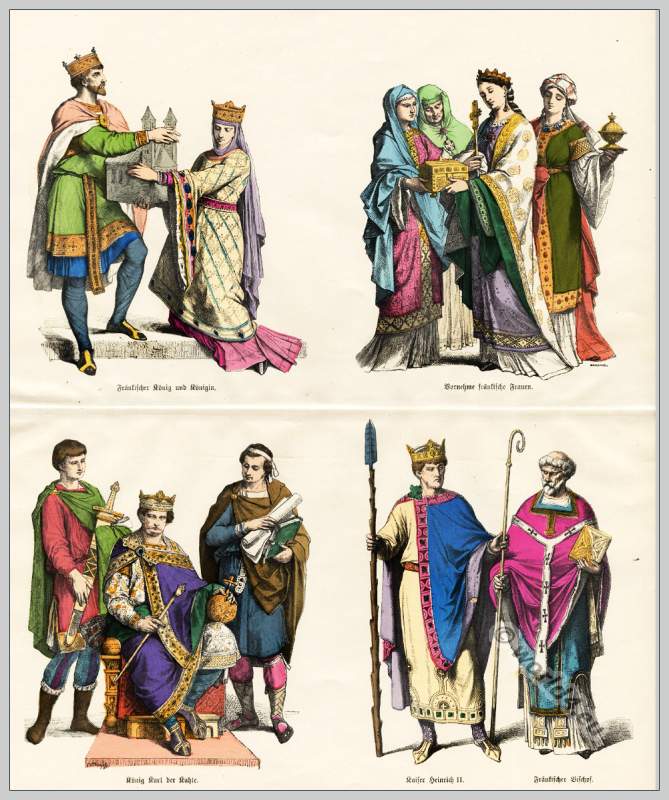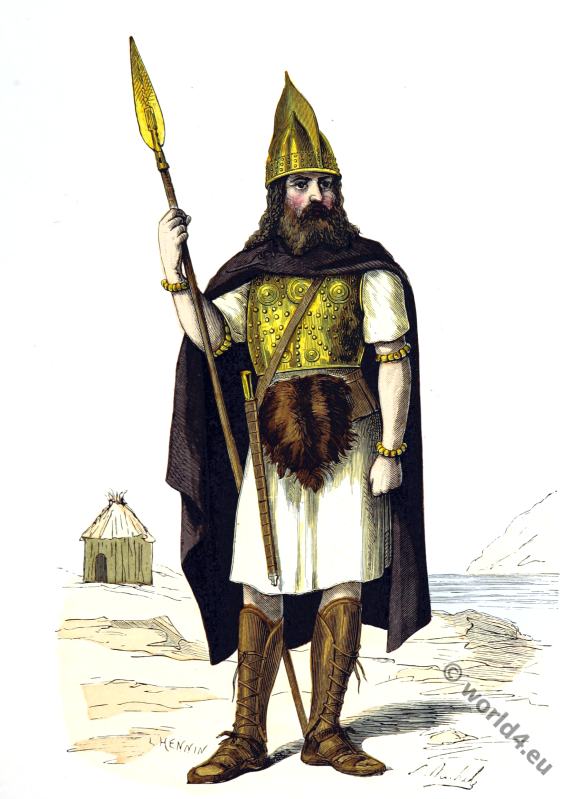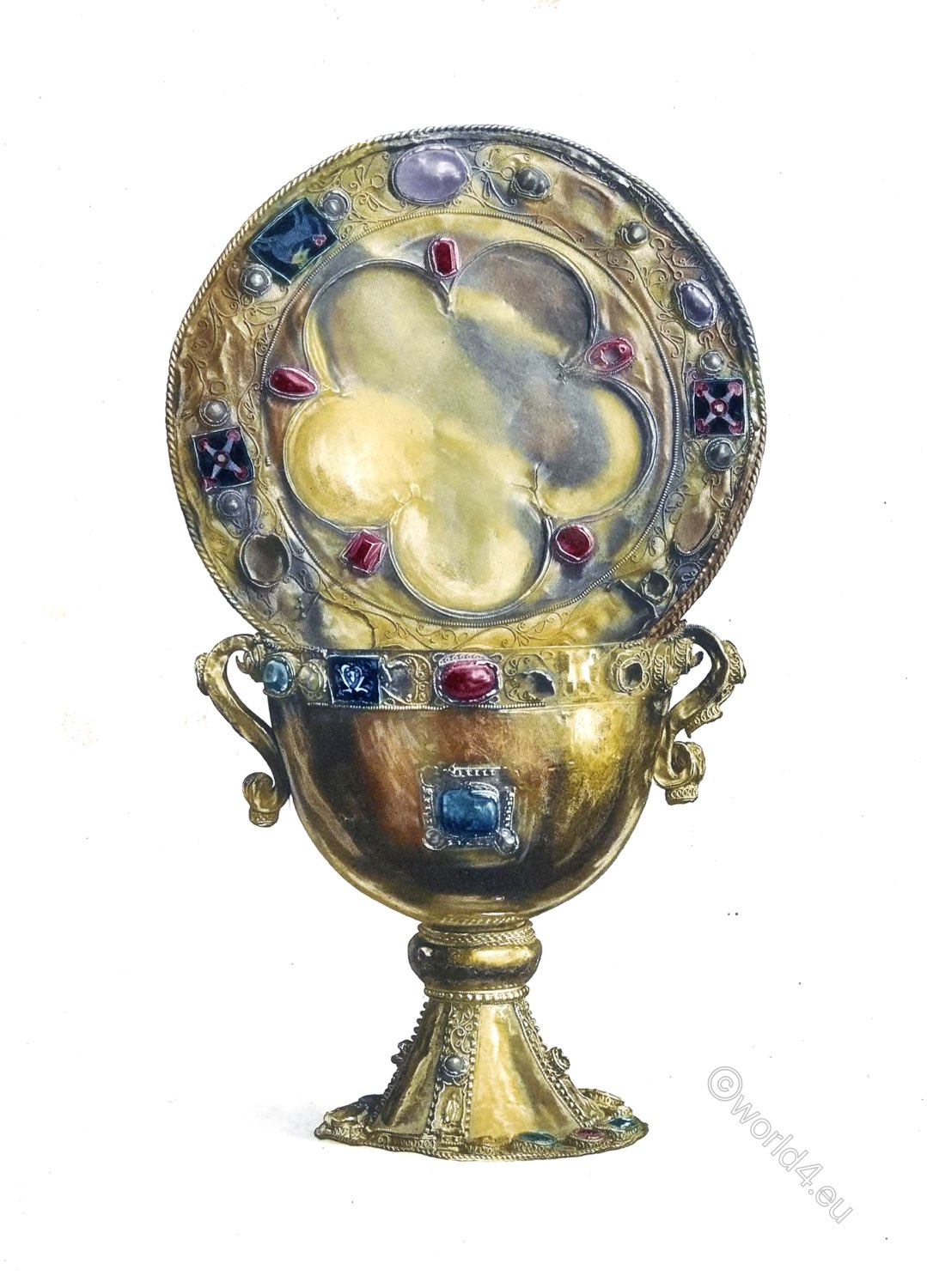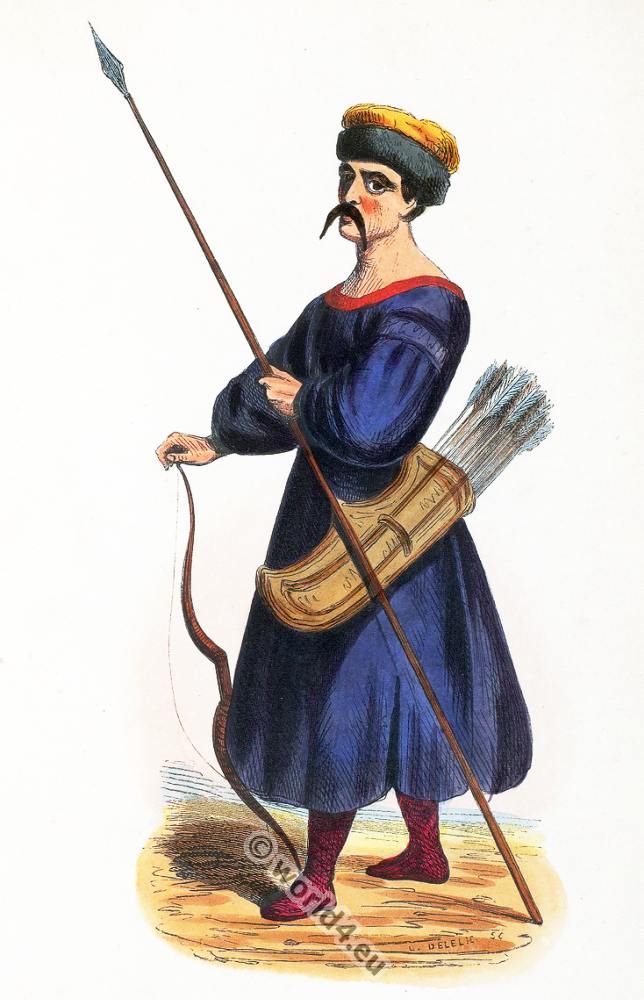Armed infantry warrior in brigandine. France 10th century.
Guerrier arme de la Brigantine. X° Siècle.
The brigandine offered good protection against arrows and was cheaper than the hauberk or breastplate of iron. Mainly carried by infantrymen, archers and crossbow, it was used until the sixteenth century.
BRIGANDINE, BRIGANTAYLE, BRIGANDYRON.
Body armour composed of iron rings or small thin iron plates, sewed upon canvas, linen, or leather, and covered over with similar materials, deriving its name from troops called brigans, an irregular sort of infantry of the thirteenth century, by whom they were first worn. When covered with white linen, cloth, or fustian, they were called “miller’s coats”; but persons of condition had them covered with silk velvet and cloth of gold. Archers and cross-bowmen are generally represented in these quilted coats or jackets. (Specimens are to be seen in the Tower and other collections.) “Lequel l’Estourmey vestit icelles brigandines …. en disant que cestoit une belle jaquette.” (Lit. Remiss. A.D. I456). Meyrick describes the one in his collection “as composed of a great number of rudely-shaped pieces of flat iron, quilted between two pieces of canvas, the exterior being of a sky blue colour, and the small cords which perform this operation are seen in straight and diagonal lines knotted together at their intersections outside.” Skelton has engraved a portion of it, showing the holes in the edge for lacing it down the front.
Grose observes that it is frequently confounded with the JACK, and sometimes with the HABERGEON; but see those words, and also JAZERANT. In Brander’s MS. (‘Inventory of Armour in the Royal Arsenals,’ 1546), were mentioned a variety of brigandines, some styled “complete,” having sleeves covered with crimson, or cloth of gold, others with blue satin, and some with long taces or skirts. “Of armis and of brigantayle, Stood nothing thanne upon batayle.” Gower MS., Soc. Arch.
Source: A cyclopedia of costume, or, dictionary of dress, including notices of contemporaneous fashions on the continent; a general chronological history of the costumes of the principal countries of Europe, from the commencement of the Christian era to the accession of George the Third, by Planch, James Robinson, 1796-1880″
Picture from the book: Histoire de l’Armée et de tous les régiments depuis les premiers temps de la Monarchie jusqu’à nos jours par M. Adrien Pascal. Paris, Dutertre, Libraire -Editeur 1861.
Illustré par M. Philippoteaux, E. Charpentier, H. Bellangé, de Moraine, Morel-Fatio, Sorieul, etc.
Adrien Pascal (1815-1863) was a French military historian. He was the head of department of advertising at the Imperial Commission of the Universal Exhibition of 1855.
Related:
[sitecreator show=”20″]
Related to:
Byzantine, Medieval, Gothic, Burgundian, Renaisance fashion history
- The Barbarian Invasions. The Migration Period. (Historical Atlas)
- The Gallic and Gallo-Roman costume period. 3rd to 4th century
- Byzantine costume history. 5th to 6th century.
- Frankish Merovingian costume history. 4th and 5th century
- Carolingian Period 752-987. Reign of Charlemagne.
- The Carolingian Fashion Period 987 to 1270.
- Europe in the time of Charles the Great 768 – 814. (Maps, Places).
- The Corset and the Crinolin. Fashion history from Ancient until 19th century.
- 11th to 13th century. French fashion history.
- 11th to 13th century. German fashion history.
- 11th to 15th century. Caps and Hoods fashion.
- 13th century. French male fashion history.
- 14th century. German fashion history.
- 15th century. German male fashion history.
- 15th century. German female fashion history.
- 14th, 15th century. Italian fashion history.
- Eleanor of Aquitaine, Medieval Queen in the 12th century. Fashion history.
- Eleanor of Castile first wife of King Edward I. England 13th century
- Reigns of John and of Charles V. 1350 to 1380. (Medieval, Byzantine, Gothic)
- Reigns of Charles VI. and Charles VII. 1380 to 1461. (Medieval, Gothic, Burgundy)
- Headdresses of the 14th Century.
- Headdresses of the 15th century. The Hennin.
- Headdresses 15th century. The Reticulated Headdress.
- The Influence of the Crusaders to the French clothing. 13th to 14th century.
- The Knights Hospitallers. The First Crusade. 11th century.
- The Knights of the Teutonic Order of Knighthood. History of German Crusaders 12th century.
- The Crusades. The Knights Templar. Medieval military religious order. 12th century.
- Syria during the period of the crusades. Maps, Names, Places. Historical Atlas.
- Life-size warrior figures in full armor and equipment. Greek, Roman, Gallic, Merovingian, Carolingian.
- Armor in England from the 10th to the 18th century
- The Rise of Monachism. Monastic costumes history.
- The Romance of the Rose. The Art of courtly love.
- The Lady of Tournament delivering the Price.
- On the history of costumes. From Ancient until the 19th century.
Discover more from World4 Costume Culture History
Subscribe to get the latest posts sent to your email.







